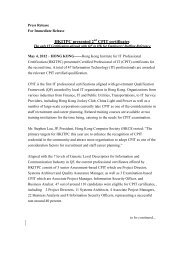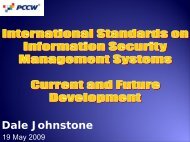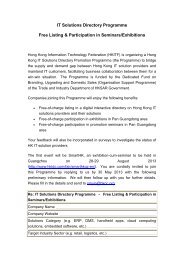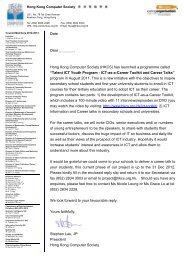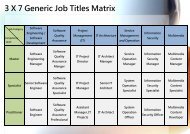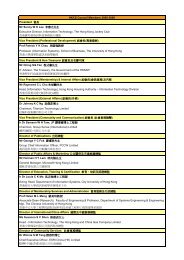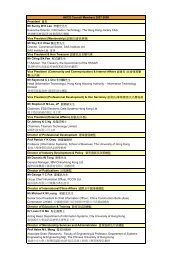TMMi Levels
TMMi Levels
TMMi Levels
- No tags were found...
You also want an ePaper? Increase the reach of your titles
YUMPU automatically turns print PDFs into web optimized ePapers that Google loves.
<strong>TMMi</strong> Introduced in 2007<strong>TMMi</strong> FoundationWhy <strong>TMMi</strong>?‣ <strong>TMMi</strong> is based on TMM (partially published in1996)‣ New CMMI replacing the old SW-CMM‣ Need for independent test maturityassessment‣ Need for standard certification‣ Focus on testing and integration with CMMI‣ A non-profit making organization‣ Dedicated to improving test processes andpractice.‣ Focus: development of a common, robust model oftest process assessment and improvement in ITorganizations – non-commercial test improvementmodel‣ As of Dec. 2009, 329 members representing 32nationalitiesCompanies from UK, India, Korea and Japan have usedthis model.<strong>TMMi</strong>Page 1Hareton Leung, 2010Page 2<strong>TMMi</strong>Hareton Leung, 2010<strong>TMMi</strong> FoundationProvides‣ A standard staged TMMI model that can be used in isolationor in support of other Software Process Improvementmodels‣ An independently managed data repository to support TMMIassessment method accreditation, assessor andassessment certification/validation and validatedassessment data and certificates‣ Assessment method accreditation/audit framework for TMMIin accordance with ISO15504‣ Certification i and training/examination i i i process, proceduresand standards for formal, public accreditation of assessorsand lead assessors and the on-going management.Page 3<strong>TMMi</strong>Hareton Leung, 2010<strong>TMMi</strong> <strong>Levels</strong>Level 5 OptimizationDefect preventionTest process optimisationQuality controlLevel 4 Management and MeasurementTest measurementSoftware quality evaluationAdvanced peer reviewsLevel 3 DefinedTest organizationTest training programTest life cycle and integrationNon-functional testingPeer reviewsLevel 2 ManagedTest policy and strategyTest planningTest monitoring and controlTest design and executionTest environmentLevel 1 InitialPage 4<strong>TMMi</strong>Hareton Leung, 2010
Components within eachMaturity LevelelindicatesTest processcapabilityMaturityLevelachievesSpecific andGeneric GoalscontainsProcessAreaImplementationdescribescontainsPractices(Specific,Generic)Level 1 Organization• Testing is a chaotic and is often considered a partof fdebugging.• The organization usually does not provide a stableenvironment to support testing.• Success in these organizations depends on thecompetence and heroics of the people in theorganization.• Tests are developed in an ad-hoc way after codingis completed.• The objective of testing is to show that the softwareruns without major failures.54321Page 5<strong>TMMi</strong>Hareton Leung, 2010Page 6<strong>TMMi</strong>Hareton Leung, 2010Level 1 OrganizationLevel 2 Organization• The delivered e ed product often does not fulfill its needs, isnot stable, or is too slow to work with.• Within testing there is a lack of resources, tools andwell-educated staff.• Organizations are characterized by a tendency to overcommit, abandonment of processes in a time of crises,and an inability to repeat their successes.• Products tend not to be released on time, budgets areoverrun and quality is not according to expectations. 5• No defined process areas. 4321Page 7<strong>TMMi</strong>Hareton Leung, 2010• Testing becomes a managed process and is clearlyseparated from debugging.• Testing is still perceived as being a project phase thatfollows coding.• A company-wide or programme-wide test strategy isestablished.• Test plans are also being developed. The test plandefines test approach and what testing is required,when, how and by whom.• Risk management techniques are used to identify the 5product risks based on documented d requirements.43• Testing is monitored and controlled to ensure it is2going according to plan. 1Page 8<strong>TMMi</strong>Hareton Leung, 2010
Level 5 Organization• Defect prevention and quality control are practiced.Statistical sampling, measurements of confidencelevels, trustworthiness, and reliability drive the testprocess. The test process is characterized bysampling based quality measurements.• A detailed procedure exists for selecting andevaluating test tools. Tools support the test process asmuch as possible during test design, test execution,regression testing, test case management, etc.• Process reuse is also practiced by a process assetlibrary.• Testing is a process with the objective to preventdefects.54321Some StatisticsAccording to a study done by Experimentus of UK‣ Survey 100 companies‣ 72.5% were at <strong>TMMi</strong> level 1 (they are working in achaotic, hero-based way but starting to build projectbased processes)‣ 27.5% were at <strong>TMMi</strong> level 2 (they have someestablished project based process and are movingtowards implementing process at an organizational level)l)‣ More than 70% of respondents do not have metrics inplace to monitor or manage testing goals.Page 17<strong>TMMi</strong>Hareton Leung, 2010Page 18<strong>TMMi</strong>Hareton Leung, 2010Development of <strong>TMMi</strong>References‣ Level 2 and 3 have been defined and used‣ A working group is developing level l 4 and 5 now.Work Plan• Jan 29: Submit draft of ML4 Process Area Preamble (Scope,Purpose) and Specific Goals to review committee• Mar 09: Submit draft of ML5 Process Area Preamble (Scope,Purpose) and Specific Goals to review committee• Mar 26: Submit draft of ML4 Specific and Generic Practicesto review committee• May 04: Publish Maturity Level 4• Jun 01: Submit draft of ML5 Specific and Generic Practicesto review committee• Jul 13: Publish Maturity Level 5<strong>TMMi</strong> version 2, http://www.tmmifoundation.org/A Model to Assess Testing Process Maturity - Nov 98,Crosstalk,http://www.stsc.hill.af.mil/crosstalk/1998/11/burnstein.aspWe invite you to participate in the development of <strong>TMMi</strong>level 4 and 5.If interested, please contactHareton Leung, 27667252, cshleung@comp.polyu.edu.hkPage 19<strong>TMMi</strong>Hareton Leung, 2010Page 20<strong>TMMi</strong>Hareton Leung, 2010





